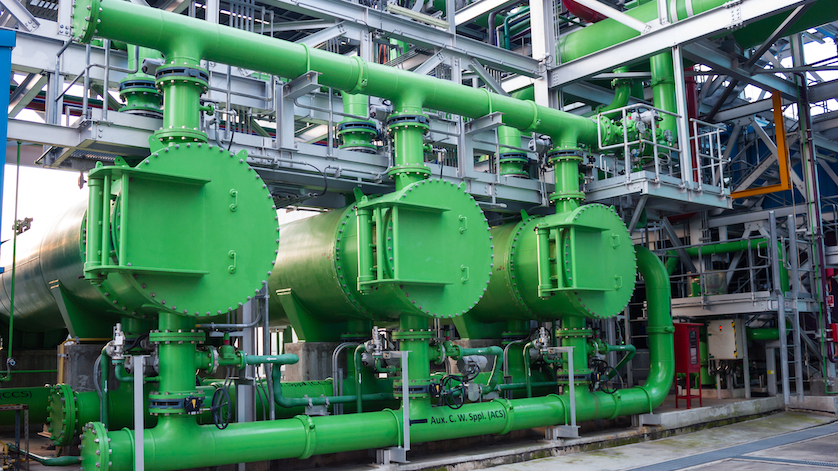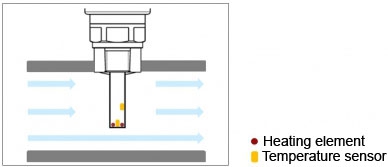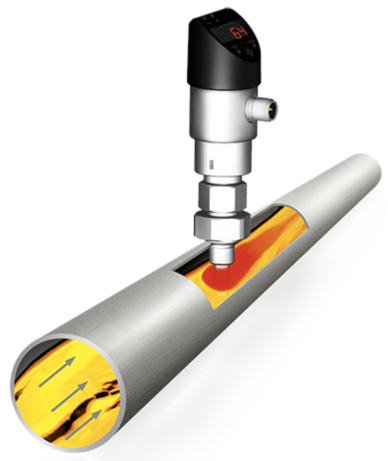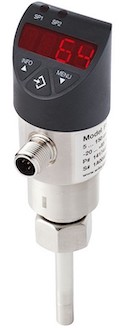
With high precision, digital or analog output, and no moving parts, thermal flow monitors are ideal for applications with contaminated or aggressive media.
A thermal flow monitor, sometimes referred to as calorimetric flow switch or simply an electronic flow switch, is a device that monitors and controls the flow of liquids in a pipeline. These instruments are found in cooling lubricant systems, coolant circuits, filter units, and pumping systems.
How Thermal Flow Monitors Work

Illustration of the two sensors in a thermal flow switch
An electronic flow switch use the law of conservation of energy to measure the flow rate in order to control it. It measures flow using the calorimetric principle, which states that the total heat lost by the hot body is equal to the total heat gained by the cold body.
To that end, within every electronic flow switch are two temperature sensors at the measuring probe. One sensor measures the temperature of the liquid medium (the cold body) flowing through the pipeline. The other sensor measures the temperature at the heating element (the hot body), using one of two methods:
- Continuous heating – using constant power to heat the sensor
- Regulated heating – maintaining a constant temperature difference between the two sensors using a variable power for the heated sensor

electronic flow switch mounted on pipeline
Using the calorimetric principle to detect flow rate
Flowing liquid has a cooling effect on heated elements. As the molecules of the flowing medium encounter the heated sensor, it carries some of the heat away.
In the continuous heating configuration, the faster the flow in the pipeline, the more the molecules cool the heated sensor. This creates a smaller difference in the temperature between the two sensors. These temperature differences can be calculated to arrive at the medium’s flow rate in a pipeline.
In the regulated heating configuration, as the flowing medium cools the heated sensor, that sensor responds by providing more heating power in order to maintain a constant temperature difference. Based on how much extra power is supplied, the sensor makes a calculation to arrive at the medium’s flow rate in a pipeline.
In either method, the sensor’s output signal is received by the controller, which triggers a switching function at preset limits.

FSD-4 electronic flow switch with optional temperature output
Advantages of Using an Electronic Flow Switch
Calorimetric flow switches are a great solution for controlling and monitoring of cooling circuits and lubricants, and preventing the effects of blockage in filters. They also act as dry run protection in pumps. Based on the calorimetric measuring principle, WIKA’s FSD-4 electronic flow switch with display is the ideal solution monitoring and controlling flow in a pipeline:
- Mechanical and magnetic flow switches rely on a series of moving parts to activate this function. Electronic flow switches have no moving parts, making them free of the wear and tear that cause malfunctions.
- They are virtually maintenance-free. Only when the medium is particularly viscous is periodic cleaning of the probe necessary.
- Thermal flow switches work well with electrically nonconductive media, such as oil and grease.
- The wetted parts – measuring probe and process connection – of the FSD-4 are made of stainless steel 316Ti to better resist aggressive and corrosive media.
- Electronic flow switches have a high tolerance for variations in media temperature, density, and conductivity.
- The FSD-4 is easy to parameterize using the 3-button operation on the display, or via the option of IO-Link 1.1.
- Electronic flow switches can be two sensors in one: In addition to flow rate, the FSD-4 has the option for temperature output as well.
WIKA USA, Smart in Flow Sensing
WIKA is a global leader in high-quality, easily customizable flow measurement solutions. Contact us for more information about our flow switches or other flow products.
Product mentioned in this article:
• FSD-4 electronic flow switch with display

